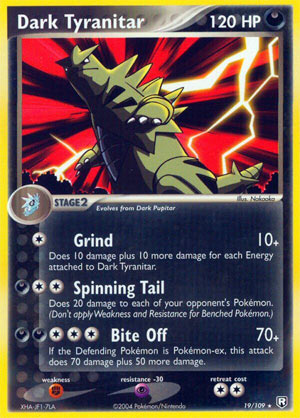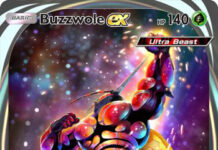
Dark Tyranitar
– Team Rocket Returns #19
Date Reviewed:
March 28, 2019
Ratings Summary:
See Below
Ratings are based on a 1 to 5 scale. 1 is horrible. 3 is average. 5 is great.
Reviews Below:
 Otaku Dark Tyranitar (EX – Team Rocket Returns 19/109) was not the first Dark Tyranitar card – that would be Dark Tyranitar (Team Rocket 11/105) – nor is it the only Dark Tyranitar card from its own set – Dark Tyranitar (EX – Team Rocket Returns 20/109). I vaguely recall players trying to make the original Dark Tyranitar competitive, but never coming close to succeeding. For a time, lists running one or both Dark Tyranitar from EX – Team Rocket were the decks to beat. By the time of the 2005 World Championships, nine months after Dark Tyranitar (EX – Team Rocket Returns 19/109) and Dark Tyranitar (EX – Team Rocket 20/109) had released, their influence had ebbed. However, they were still strong enough that Takashi Yoneda piloted a deck featuring the two Dark Tyranitar to second place in the Senior Age Division or the 2005 World Championship. We’re also reviewing Dark Tyranitar (EX – Team Rocket Returns 20/109) today; we once again have two cards so closely related we need to discuss them at the same time but different enough they really need their own entries. Don’t be surprised if I repeat myself a lot in the reviews, however, since the two cards have so much in common. After all, I’ve got to at least touch on several mechanics no longer used or used the same way in the modern game, in addition to more general differences between the metagames. Dark Tyranitar does not count against Tyranitar with respect to the 4-Copy Rule; you could run four of each in the same deck. The other Dark Tyranitar cards do count against each other for the 4-Copy Rule. Dark Tyranitar evolves from Dark Pupitar but Dark Pupitar evolves from regular Larvitar. This is different from other major examples of the “owner” mechanic, as cards like Team Magma’s Aggron would Evolve from Team Magma’s Lairon and that from Team Magma’s Aron. For those unfamiliar with the “owner” mechanic, it is when something in the card’s name denotes it as belonging to a specific character or group. There were pieces of themed support just for Pokémon with “Dark” or “Rocket’s” in their name at this time, and I thought there were counters or at least beneficial effects which excluded them but I’m not finding them with my searches; maybe I’m remembering it wrong or maybe I’m just using the wrong keywords/phrases in my inquiries. Dark Tyranitar is a Stage 2 Pokémon, but it doesn’t mean the same thing now as it did back then… in fact, you might think of it as the opposite. Dark Tyranitar released at a time when Basic Pokémon were usually “filler” and Evolutions dominated the metagame. Part of this was an intentional imbalance, an overcorrection due to the dominance by Basic Pokémon in the early days of the game. Part of this was due to the often stifling first-turn rules of the time, something so complicated it deserves its own article, but I’m afraid I lack the time or detailed knowledge for it. The final piece was Rare Candy; before the Black & White-era, it not only allowed you evolve a Basic Pokémon directly to the corresponding Stage 2 but could do so the first turn that Pokémon was in play, possibly your first turn of the game (when the first-turn rules cooperated). Back then you could even use it to evolve the selected Basic into the correct Stage 1 form, helping those out as well. The [D] Typing of Dark Tyranitar is not too dissimilar to what it is like now; [D] Weakness HAD been introduced to the game by this point, found on certain [P] Types that were representing the video game Ghost Type. There also weren’t any [D] Resistant Pokémon I could find in the relevant cardpool. What was different is that this predates Darkness Energy as a basic Energy card. There was a card named “Darkness Energy” but it was a Special Energy that provided [D] and a +10 damage bonus for [D] Types and Pokémon with “Dark” in their names. Fortunately for Dark Tyranitar, there were several Special Energy capable of meeting [D] requirements; Dark Metal Energy, Double Rainbow Energy, R Energy, and Scramble Energy. Dark Tyranitar has 120 HP, and while that is pretty small for a Stage 2 Pokémon now, it was the maximum printed allowed for ANY Stage of Evolution that was not also a Pokémon-ex. Yes, lower-case “ex”; these are the predecessors of Pokémon-EX/GX, basically Pokémon-GX without GX-attacks and less 15 years worth of power creep. It was very hard to OHKO this number back then, and you needed a solid deck played well if you wanted to ensure a 2HKO (Weakness excluded). Weakness wouldn’t guarantee a OHKO back then but made for easy 2HKOs when it didn’t. Unfortunately for this card, we see [F] Type attackers in All four 2005 World Championship decks. I do not recall how common [P] Type attackers were at this time, but odds were decent that it came in handy at least from time to time and remember, this is “old school” Resistance, worth -30 instead of -20 at a time when attacks were about half as strong as they are in the present. The Retreat Cost of [CC] was adequate; we didn’t have as many tricks for easily paying it – Double Colorless Energy wasn’t even legal at this point – or reducing it, but we did have some. Dark Tyranitar has three attacks. For [C] it could use “Grind” to do 10 damage per Energy attached to itself. Recalling that HP scores and damage output were much lower, this was actually a solid attack; not amazing, but it gave you something decent to do while building to one of the card’s more costly options. [DCC] paid for “Spinning Tail”, which did 20 to all of your opponent’s Pokémon; besides your opponent’s Bench-size, there were many combo-pieces that could make (arguably break) this attack. [DDCCC] was a pretty painful price to meet for “Bite Off”; as mentioned earlier, there was no basic Energy card version of Darkness Energy at this time. Still, you had the options mentioned above and the payout was 70 damage plus 50 more if you were attacking a Pokémon-ex. At this point in the game’s history, you expected at least 10 damage per [C] Energy requirement and 15 per [D], PLUS bonuses for being a Stage 2 AND requiring an abnormal amount of Energy. In other words, 70-for-five was underwhelming, but when the bonus damage kicked in it was good. While Pokémon-ex at this time could have upwards of 200 HP, most did not. Stage 2 Pokémon-ex had between 130 and 160, Stage 1 Pokémon-ex other than Wailord-ex (the record holder) had between 90 and 150, and no Basic Pokémon-ex had more than 120. While damage buffs were far rarer at this time, Dark Tyranitar had access to both the Special Energy card version of Darkness Energy and R Energy, which did grant damage bonuses in addition to their other effects. There was also the possibility of Bench damage from Spinning Tail leading to a pseudo-OHKO. When we put it all together, during the Modified (Standard) legal lifespan of this card, it looks solid. To understand why it was great, we need to start looking at a few other cards. I’ll go into detail about Dark Tyranitar (EX – Team Rocket Returns 20/109) in its own review, but it had the same Stage and HP as this version but was a dual-Type Pokémon, both [D] and [F]. It was [G] Weak, giving you a better chance against those multiple [F] Type attackers I mentioned, but the main thing was its Poké-Body. Poké-Bodies (and Poké-Powers) are non-attack effects similar to but mechanically distinct from Abilities; while Dark Tyranitar (EX – Team Rocket Returns 20/109) was Active, its “Sand Damage” Poké-Power placed a damage counter on each of your opponent’s Pokémon. You might then take advantage of its “Second Strike” attack, but when we look at Takashi Yoneda’s build, we see he had other options. I was surprised by the lack of Surprise! Time Machine in the deck, as I used them in my own version back in the day; maybe I was wrong, but I thought it was handy being able to swap between the two versions of Dark Tyranitar on the fly. What most of us also got right was combining Sand Damage with Desert Ruins (the Shrine of Punishment for its day) and Ancient Technical Machine [Rock]. After just a few turns, all of your opponent’s Pokémon would have enough damage counters on them that those Evolved from the typical (40 to 60 HP) Basic Pokémon of this time would be KO’d by bouncing their highest Stage of Evolution… especially as most Stage 2 had skipped their Stage 1 states via Rare Candy. It was so effective, we eventually saw cards like Battle Frontier, which disabled Sand Damage as well as the “Quick Search” Poké-Power Pidgeot (EX – Fire Red & Leaf Green 10/112). Ratings Standard: N/A Expanded: N/A Limited: 2/5 Dark Tyranitar (EX – Team Rocket Returns 19/109) was the more abundant version in Takashi Yoneda’s build; I remember some decks running only it, some favoring the other version, and some even leaving today’s Dark Tyranitar out completely, but it looks like it won out in the end. If you’re wondering why we looked at it, remember that we looked at Battle Frontier (counters the other Dark Tyranitar), Ancient Technical Machine [Rock] (useful to both), and Surprise! Time Machine (useful to both). |
We would love more volunteers to help us with our Card of the Day reviews. If you want to share your ideas on cards with other fans, feel free to drop us an email. We’d be happy to link back to your blog / YouTube Channel / etc. 😉
Click here to read our Pokémon Card of the Day Archive. We have reviewed more than 3500 Pokemon cards over the last 17+ years!



